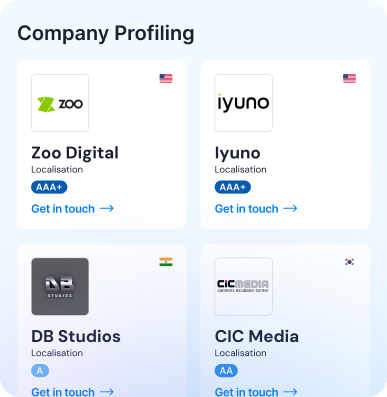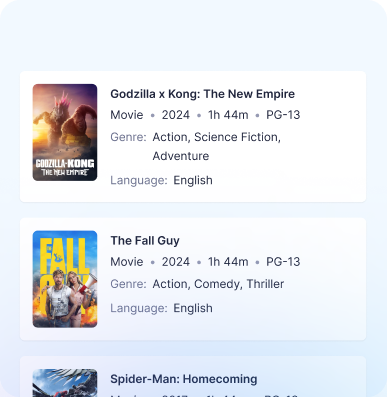Introduction
Ever wonder how Netflix just knows what you want to watch?
It’s not magic, it’s a meticulously crafted machine. Today, we’re diving deep into Netflix’s Content Acquisition Strategy. Understanding this powerhouse can give you serious leverage, whether you’re creating, selling, or distributing content.
For years, I’ve seen companies struggle to decode what makes global streaming giants tick.
They pour money into content, hoping something sticks. But hope isn’t a strategy. Netflix, on the other hand, has turned content acquisition into a science, blending data, global ambition, and a relentless focus on subscribers. In this post, I’m going to walk you through the core pillars of their approach so you can adapt these insights for your own success.
Curious how Vitrina can help you? Try it out today!
Trusted by global entertainment leaders to grow business, acquire high-demand content, promote projects and services, and track every Film + TV production worldwide
Table of content
- Introduction
- Key-Takeaways
- Understanding Netflix’s Core Philosophy
- Step 1: The Data-Driven Engine Behind Content Choices
- Step 2: The Strategic Shift to Originals Over Licensing
- Step 3: Going Global – Localization and International Expansion
- Step 4: Diversification is Key – Catering to Every Taste
- Step 5: The Billions Behind the Binge – Spending and Talent
- How Vitrina Helps You Navigate the Content Landscape
- Conclusion
- FAQs
Key Takeaways
| Aspect of Strategy | Key Insight | Actionable Tip for You |
|---|---|---|
| Data-Driven Decisions | Netflix uses viewing data to greenlight, personalize, and acquire content. | Leverage available audience analytics to inform your content choices. |
| Original Content Focus | Shift from licensed to Originals (“Netflix Originals”) to control IP and brand. | Consider developing unique IP to build long-term value and reduce reliance on third parties. |
| Global Domination | Invests heavily in local content for international markets, then globalizes successful shows. | Explore niche international markets and content that has cross-cultural appeal. |
| Diverse Content Portfolio | Acquires and produces a wide range of genres, formats, and budget levels. | Don’t put all your eggs in one basket; diversify your content offerings. |
| Aggressive Spending & Talent Acquisition | Commits billions annually to content and attracts top-tier talent. | Focus on strategic partnerships and co-productions if budgets are a constraint. |
Need to Boost Your Content ROI?

Understanding Netflix’s Core Philosophy
Before we dive into the “how,” let’s touch on the “why.” Netflix isn’t just a streaming service; it’s a content engine designed to maximize subscriber acquisition and retention.
Their entire Netflix’s Content Acquisition Strategy revolves around a simple premise: have something for everyone, all the time, everywhere.
This means appealing to diverse tastes, demographics, and cultures. It’s about creating a library so compelling that the monthly subscription feels like a steal. Think about it – when was the last time you thought, “There’s NOTHING on Netflix?” Even if you don’t find a blockbuster, there’s always something intriguing enough to keep you scrolling, and more importantly, subscribed.
Step 1: The Data-Driven Engine Behind Content Choices
You’ve heard it before: data is the new oil. For Netflix, it’s the lifeblood of their content strategy. They don’t just guess what you’ll like; they know, or at least have a very educated prediction.
How Netflix Uses Data
- Viewing Habits: What you watch, when you watch, what device you use, if you pause, rewind, or abandon a show. They even track searches for content they don’t yet have.
- Content Greenlighting: Data informs decisions on which shows to produce or acquire. If a certain genre, actor, or director is popular in a region, they’ll lean into it. Remember “House of Cards”? It wasn’t a blind bet; data suggested David Fincher and Kevin Spacey were a potent combination for their audience.
- Personalization: The recommendation engine is legendary. It ensures that the right content finds the right eyes, maximizing engagement.
- Marketing Efficiency: They even use data to create trailers and promotional materials tailored to different audience segments for the same show.
Want to emulate this? You don’t need Netflix’s billions. Start by deeply analyzing the data you do have access to. What are your audience engagement metrics telling you? Look at social media sentiment, survey data, or even industry reports on trending genres. For deeper insights into global content performance and trends, platforms like Vitrina’s market intelligence can be invaluable.
Step 2: The Strategic Shift to Originals Over Licensing
Remember when Netflix was primarily a hub for other studios’ movies and TV shows? Those days are long gone. While licensed content still plays a role, the crown jewel of Netflix’s Content Acquisition Strategy is “Netflix Originals.”
Why Originals?
- Brand Building: Originals create a unique identity. Shows like “Stranger Things,” “Bridgerton,” or “Money Heist” are synonymous with Netflix.
- IP Control: Owning the intellectual property means they control global distribution rights, merchandising, and potential spin-offs, without complex, expiring licensing deals.
- Long-Term Value: Licensed content can disappear when deals end (think “Friends” or “The Office”). Originals stay on the platform forever, continuously adding value.
- Competitive Moat: As competitors like Disney+, HBO Max, and Amazon Prime Video pulled their content back for their own platforms, Netflix’s investment in Originals proved incredibly prescient.
For content creators and distributors, this means the demand for fresh, original IP is higher than ever. If you’re developing unique stories, you’re in a strong position. Consider how you can build your own library of owned content, even on a smaller scale.
Ready for Smarter Content Decisions?

Step 3: Going Global – Localization and International Expansion
Netflix isn’t just an American company; it’s a global entertainment force. A huge part of their content acquisition success is their “local to global” approach.
Tackling the World Market
- Local Content Investment: Netflix invests heavily in producing local-language content in numerous countries – think “Dark” (Germany), “Sacred Games” (India), or “Lupin” (France). This caters directly to local tastes and regulatory requirements.
- Globalizing Hits: When a local show becomes a hit (like “Squid Game” from South Korea), Netflix leverages its global platform to turn it into an international phenomenon. This is a game-changer.
- Cultural Nuance: It’s not just about dubbing and subtitles. They are increasingly working with local writers, directors, and production companies who understand the culture.
This international focus opens massive opportunities. If you’re creating content with universal themes, or if you’re a provider in a specific region, understanding these global content flows is crucial. Keeping track of what’s being produced where, and by whom, can highlight new avenues for partnership or distribution. The Vitrina Project Tracker, for instance, offers visibility into ongoing productions globally.
Step 4: Diversification is Key – Catering to Every Taste
Walk through Netflix’s virtual aisles, and you’ll find an incredible array of content. From big-budget action films and prestige dramas to reality TV, documentaries, stand-up comedy, animation, and kids’ programming. This isn’t accidental; it’s a core tenet of Netflix’s Content Acquisition Strategy.
The “Something for Everyone” Playbook
- Genre Spread: They don’t just focus on one or two successful genres. They aim for breadth and depth across many categories.
- Budget Variation: Not everything is a $200 million blockbuster. They also invest in lower-budget, niche content that can find a passionate audience. Think indie films or specialized documentaries.
- Format Experimentation: Interactive content like “Black Mirror: Bandersnatch” or unscripted hits show a willingness to explore different ways to engage viewers.
The lesson here? Don’t be afraid to diversify. Understanding audience segments and their specific preferences can help you identify underserved niches. A broad content slate increases your chances of hitting a nerve with different viewer groups and mitigates the risk of relying on a single type of content.
| Content Type | Netflix Example | Strategic Importance |
|---|---|---|
| Blockbuster Films | Red Notice, The Gray Man | Attracts new subscribers, creates buzz |
| Prestige TV Series | The Crown, Ozark | Retains subscribers, wins awards, critical acclaim |
| Local Language Series | Money Heist (Spain), Squid Game (Korea) | Drives international growth, uncovers global hits |
| Documentaries | Making a Murderer, My Octopus Teacher | Serves niche interests, generates conversation |
| Unscripted/Reality | Love is Blind, Selling Sunset | Cost-effective, high engagement, social buzz |
Step 5: The Billions Behind the Binge – Spending and Talent
Let’s talk numbers. Netflix spends an astronomical amount on content – upwards of $17 billion annually in recent years. This massive budget is a key enabler of their strategy, allowing them to outbid competitors for hot projects and fund a vast slate of Originals.
Fueling the Content Machine
- Aggressive Spending: This sheer financial firepower allows them to take big swings on ambitious projects and talent.
- Talent Deals: They’ve signed lucrative multi-year deals with prolific creators like Shonda Rhimes, Ryan Murphy, and the Duffer Brothers, ensuring a steady pipeline of high-profile content.
- Acquisitions and Licensing: While Originals are key, they still strategically acquire finished films and license select content to fill gaps or capitalize on timely opportunities.
While you might not have Netflix’s budget, the principle of investing in quality and talent remains. Focus on smart spending. For many, this means seeking co-production partners, exploring financing options, or identifying emerging talent before they become A-listers. Understanding the global Media & Entertainment supply chain can help pinpoint potential partners and collaborators who align with your budget and vision.
How Vitrina Helps You Navigate the Content Landscape
Understanding Netflix’s Content Acquisition Strategy is one thing; applying those lessons is another.
That’s where Vitrina comes in. If you’re looking to acquire content, find production partners, or simply understand the global M&E marketplace dynamics, Vitrina provides the data and insights you need.
Our platform offers comprehensive information on content availability, production companies, service providers, and global content trends, helping you make more informed decisions faster. We empower businesses to discover, connect, and transact more efficiently in the complex world of content.
Conclusion
So, there you have it – a look under the hood of Netflix’s Content Acquisition Strategy.
It’s a powerful blend of data science, creative vision, global ambition, and, yes, a hefty budget. But the core principles – understanding your audience, valuing original IP, thinking globally, diversifying, and investing wisely – are lessons anyone in the media and entertainment space can learn from.
It’s not about copying Netflix, but about adapting their smartest plays to your own game. The content landscape is always evolving, but a strategy rooted in data and a deep understanding of viewer desires will always be a winner.
What’s the first strategy you’re going to try? Let me know in the comments.
Ready to supercharge your own content strategy? Get the insights and connections you need. Sign up for Vitrina today and tap into a world of M&E intelligence.
Frequently Asked Questions
Netflix primarily uses a data-driven approach. They analyze vast amounts of viewer data—what people watch, search for, how long they watch, etc.—to identify trends, popular genres, actors, and directors. This data heavily influences decisions to greenlight original productions or acquire specific licensed content that aligns with subscriber preferences and strategic growth areas, particularly in international markets.
Over the years, Netflix has significantly shifted towards prioritizing original content (“Netflix Originals”). Originals offer IP control, brand differentiation, and long-term value. While licensed content still forms a part of their library to ensure variety, the core of Netflix’s Content Acquisition Strategy is now firmly rooted in creating and owning its own shows and movies to reduce reliance on third-party studios, especially as competitors launch their own streaming services.
Extremely important. Netflix invests heavily in local-language productions across the globe (e.g., in Europe, Asia, Latin America). This not only helps attract subscribers in those specific regions but has also led to breakout global hits like “Squid Game” or “Money Heist.” Their strategy involves identifying strong local stories and talent, and then using their global platform to share successful ones with a worldwide audience.
Smaller companies can’t match Netflix’s budget, but they can adopt key principles: Be data-informed: Use available analytics to understand your audience. Focus on a niche: Instead of trying to be everything to everyone, serve a specific audience exceptionally well. Value unique IP: If possible, develop or acquire content that you can own and control. Explore co-productions and partnerships: Collaborate to share costs and expand reach. Understand global trends: Use resources like Vitrina to spot opportunities in content acquisition and distribution.
































